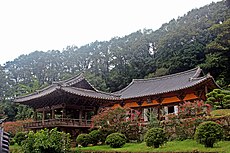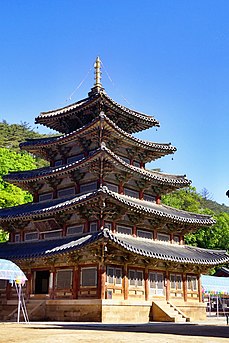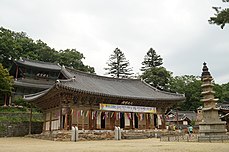Sansa (temple)
Appearance
| Sansa | |
 | |
| Korean name | |
|---|---|
| Hangul | 산사 |
| Hanja | 山寺 |
| Revised Romanization | Sansa |
| McCune–Reischauer | Sansa |
Sansa (
UNESCO World Cultural Heritage Sites.[1] With the country being largely mountainous and Buddhism deeply rooted in its history
, there are many sansas across the country.
The word sansa is composed of two words, san and sa, which mean mountain and monastery/temple respectively.
UNESCO World Heritage sansas
| Sansa | Location | Established | |
|---|---|---|---|

|
Tongdosa | Yangsan | 646[2] |

|
Buseoksa | Yeongju | 676[2] |

|
Bongjeongsa | Andong | 677[2] |

|
Beopjusa | Boeun County | Mid 8th Century[2] |

|
Magoksa | Gongju | Latter half of the 9th Century[2] |

|
Seonamsa | Suncheon | Latter half of the 9th Century[2] |

|
Daeheungsa | Haenam County | Latter half of the 9th Century[2] |
See also
- Korean Buddhist temples
- UNESCO's page for Sansa
References
- ^ "Mountain temples join Unesco list : Sansa are at least 1,000 years old and contain unique Korean elements". Korea JoongAng Daily. Retrieved 2021-02-14.
- ^ a b c d e f g "Nomination of Sansa, Buddhist Mountain Monasteries in Korea: For Inscription on the World Heritage List". whc.unesco.org. UNESCO. Retrieved 2021-11-26.
